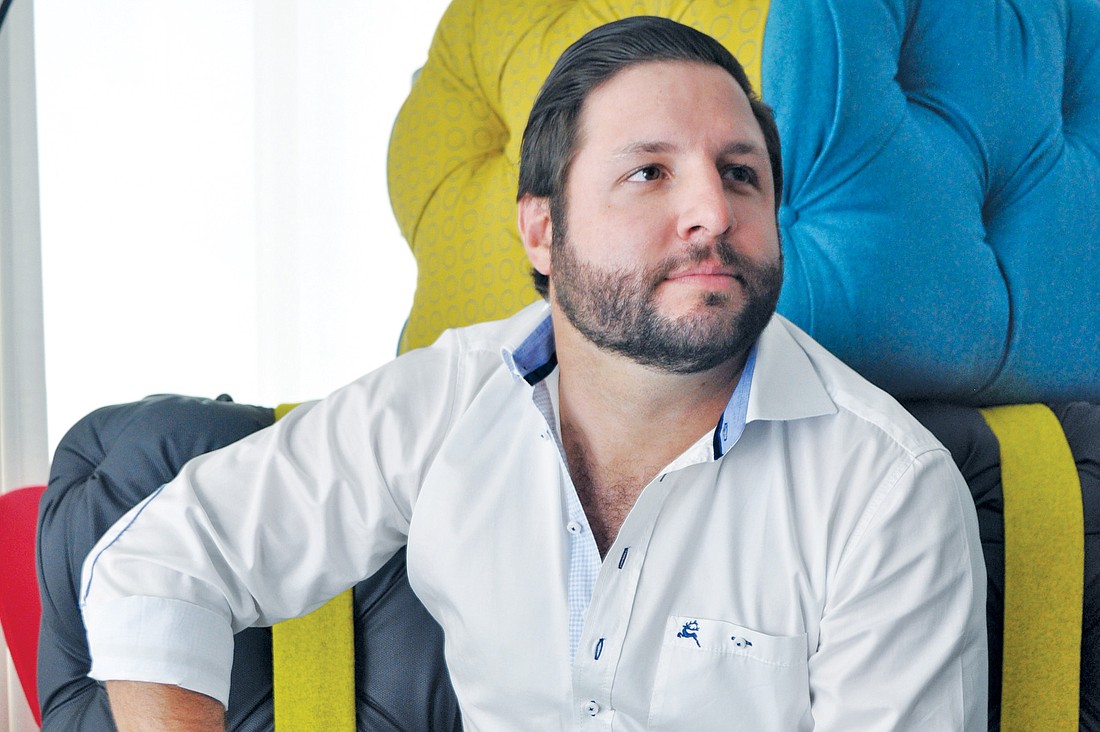- October 19, 2022
-
-
Loading

Loading

When you walk into the space that interior designer Christopher McConnell calls home, your eyes are drawn to the museum-like interior full of unique pieces of functional art, not to the blue water that lies off the back terrace overlooking Lido Beach.
There is the bold and bright pop-art pulp cartoon by local Peter Stanick, co-owner of Exit Art, in the front entrance.
The glass front doors are etched in Swiss woodlands — a representation of the view his parents enjoy through their front door of their home in Switzerland. McConnell designed it to look this way.
A giant hog statue with a serving tray on its head greets visitors as soon as they walk through the front doors.
McConnell had his eye on the table by Dutch design company Moooi for years. So, when his first clients (his parents) gave him free rein to design the family’s vacation home on Lido Beach (where he and his brother, Oliver, live) he bought the pig in a poke.
He planned for it to sit between two low-backed, royal-purple chairs in the office — until he came face to face with its monstrous proportions.
“I went to the landing deck, opened the crate and saw this huge snout staring at me,” the British-born designer says with an accent. He imagined it Babe-the-pig sized, rather than the 5-foot-long prized pig that arrived.
McConnell has an anecdote for every piece in the living quarters. For him, design should tell a story.
“I like to try to make the client a curator of (his or her) own home, so everything has a story; everything has a meaning,” he says. “I like them to be able to talk about what they buy as opposed to just buying something they see in a magazine.”
Ironically, McConnell’s own furniture design has recently been featured in magazines such as “Dwell,” “Elle Decoration,” “Wallpaper” and “Casas.”
He designed the majority of the pieces in the apartment, and his design collection grew from there. McConnell’s furniture collection debuted at the International Contemporary Furniture Fair in May in New York.
“I didn’t know what to expect, but the initial response has definitely validated my decision to start this venture,” he says. Since ICFF, he has been focusing less on interior design and more on furniture design.
It’s not hard to believe that the dapper English-born designer clad in tailored kelly-green pants always had aspirations to study fashion in New York. McConnell’s father, Roy, wanted him to get a degree in business, so he decided he’d “give it a go” at the University of Richmond in Virginia.
But not long after, McConnell transferred to Ringling College of Art and Design to study interior design.
“ … At Ringling, they really nurture your creativity,” he says. “I think that was the best part about (it); I could be as creative as I wanted to.”
During his senior year, McConnell worked for Jonathan Parks, an AIA award-winning local architect and found himself doing more architecture than interior design. He focused on the conceptual design of high-end residences and he did everything from conducting client interviews to creating the construction documents. After graduating in 2005, McConnell moved to North Carolina for three years before moving back to Sarasota a year-and-a-half ago with plans to start his own design company — a one-stop shop for interior and furniture design.
McConnell created Christopher Roy, which offers interior design services, but it’s his furniture design label, “Why Not Bespoke,” that has made a name for him.
With furniture pieces with names such as “Bees and Honey,” “Bob’s Your Uncle,” “Flowers and Frolics” and “Here and There,” it’s safe to say his Cockney heritage has influenced his work.
“There is nothing to be gained from simply following transient trends,” he says about the Spanish Mediterranean trend.
McConnell’s pieces are designed with extreme detail. The pieces are modern and artfully constructed by carefully selected craftsmen.
“All my upholstery, marble work and metal work is done in town, and all my woodwork (has been) outsourced to an Amish community in Ohio,” he says. “(The Amish) are artists more than workers. They take pride in it.”
For him, luxury isn’t a status or a price tag. It’s a service; a pride for the artisan, for the bespoke, for working with your own two hands. Luxury isn’t mass-produced.
“I’m trying to sell, not just a product, but a lifestyle,” he says.